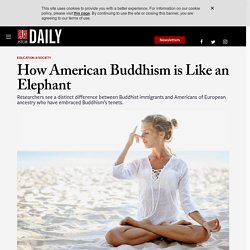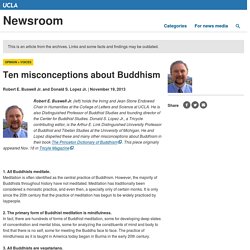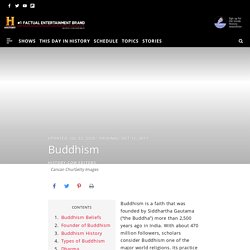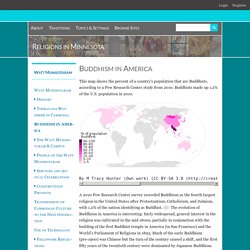

How to Identify a Buddha. HuffPost is now a part of Verizon Media. HuffPost is part of Verizon Media.

We and our partners will store and/or access information on your device through the use of cookies and similar technologies, to display personalised ads and content, for ad and content measurement, audience insights and product development. Your personal data that may be used Information about your device and internet connection, including your IP address Browsing and search activity while using Verizon Media websites and apps Precise location Find out more about how we use your information in our Privacy Policy and Cookie Policy. The Present Moment. In the history of Buddhism, popular movements that present meditation as a relatively simple practice, accessible without extensive training, are nothing new.

It happened in 8th-century China, and again in 19th-century Burma. And—growing directly out of the Burmese movement—it is happening again in today’s secularized mindfulness movement, represented most notably in the practice of MBSR, or Mindfulness Based Stress Reduction. What makes a Buddhist and how do you become Buddhist? Buddhists generally describe themselves as happy people.

But becoming Buddhist doesn’t magically change the world around us to fit our needs. So what is it that changes? To be a Buddhist, we don’t need to wear any special clothing, change our eating habits, or give up material possessions or a social life. It’s as simple as changing our perception — not taking the obstacles that come our way so seriously, and seeing everything around us as interesting and full of potential.
Simple to say but not always easy to do. By understanding the teachings and using tools like meditation, as Buddhists we gradually alter our view of whatever is happening in life. The Buddha’s teachings are a great treasury of helpful advice and each tradition emphasizes different aspects of Buddhism. Diamond Way Buddhists are lay people, often with families and regular jobs, who incorporate Buddhist methods into their daily lives. What makes you a Buddhist? We need values that we can trust. Where to start? How American Buddhism is Like an Elephant. To understand Buddhism in the United States, it helps to start with an ancient Buddhist story.

A group of blind men describe an elephant. One, who feels the elephant’s tail, describes it as a rope. Another feels the head, and says the elephant is like a boulder. The other blind men, after feeling its tusks and its belly, describe the elephant as like a long staff or a large urn. The lesson: it’s complex, and depends on which part of the elephant you examine. Buddhism first came to the United States via immigrants from Asia, and people of Asian descent still comprise the vast majority of American Buddhists, who are said to number anywhere from a million to five million.
An estimated quarter of American Buddhists are considered “converts” from traditional Christianity, Judaism, or secularist philosophies. Identifying who is a Buddhist is an arduous task for researchers. Immigrant Buddhists perceive their religious observance as rooted in family traditions. What’s an American Buddhist? Ten misconceptions about Buddhism. Robert E.

Buswell Jr. and Donald S. Lopez Jr. | November 19, 2013 Robert E. Buswell Jr. (left) holds the Irving and Jean Stone Endowed Chair in Humanities at the College of Letters and Science at UCLA. 1. Meditation is often identified as the central practice of Buddhism. 2. In fact, there are hundreds of forms of Buddhist meditation, some for developing deep states of concentration and mental bliss, some for analyzing the constituents of mind and body to find that there is no self, some for meeting the Buddha face to face. 3. Bhikṣu, the Sanskrit term translated as "monk," literally means "beggar. " Buddhism - Definition, Founder & Origins. Buddhism is a faith that was founded by Siddhartha Gautama (“the Buddha”) more than 2,500 years ago in India.

With about 470 million followers, scholars consider Buddhism one of the major world religions. Its practice has historically been most prominent in East and Southeast Asia, but its influence is growing in the West. Many Buddhist ideas and philosophies overlap with those of other faiths. Buddhism Beliefs Some key Buddhism beliefs include: Buddhism in America · Watt Munisotaram · Religions in Minnesota. This map shows the percent of a country's population that are Buddhists, according to a Pew Research Center study from 2010.

Buddhists made up 1.2% of the U.S. population in 2010. By M Tracy Hunter (Own work) [CC BY-SA 3.0 ( via Wikimedia Commons A 2010 Pew Research Center survey recorded Buddhism as the fourth largest religion in the United States after Protestantism, Catholicism, and Judaism, with 1.2% of the nation identifying as Buddhist. The evolution of Buddhism in America is interesting: fairly widespread, general interest in the religion was cultivated in the mid 1800s, partially in conjunction with the building of the first Buddhist temple in America (in San Francisco) and the World’s Parliament of Religions in 1893. Much of the early Buddhism (pre-1900) was Chinese but the turn of the century caused a shift, and the first fifty years of the twentieth century were dominated by Japanese Buddhism.